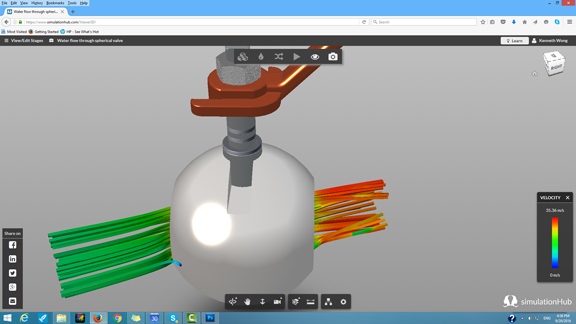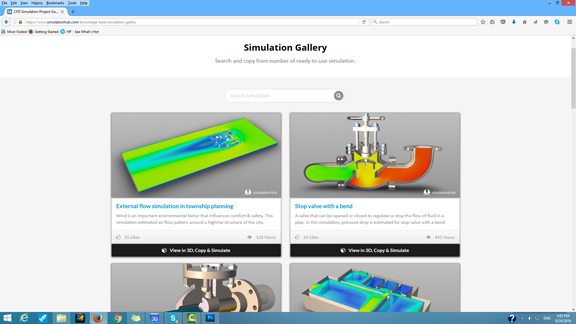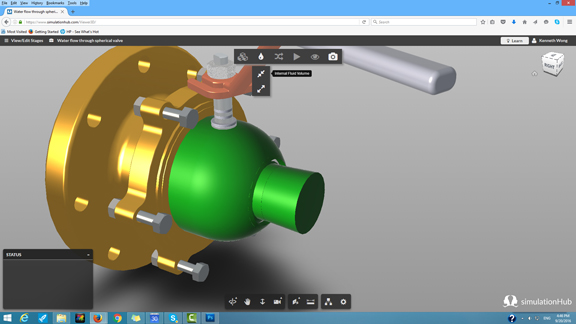
SimulationHub displays CFD results in flow tubes, flow vectors, surface pressures, and other values.
Latest News
September 22, 2016
The group of technologists who founded SimulationHub states, “We love to create awesome products to simplify complex technologies for designers and engineers.” Their dedication to this motto is reflected in the way they apply SaaS (software as a service) architecture to tackle CFD (computational fluid dynamics) problems.
Now in Beta, SimulationHub allows you to conduct fluid flow and airflow analysis from a browser. The simplified workflow reduces CFD to about half a dozen steps: You upload the model, define the liquid or air volume, specify the inlets and outlets, then run the simulation in the cloud’s expandable compute power.
 SimulationHub (now in Beta) delivers SaaS-style CFD from a browser.
SimulationHub (now in Beta) delivers SaaS-style CFD from a browser.Volume extraction—defining the region for flow analysis—can be complicated. In some CFD software, you’re required to select a series of surfaces to define the enclosure, a method that proves challenging with complex geometry. With SimulationHub, you employ a much simpler method. You click two points that signify (roughly) the boundaries of the volume; the software automatically scan the geometry within the points to figure out the volume. This approach works quite well with extracting volumes in, for example, intricate building interiors for airflow analysis; or multi-channel centrifugal pumps for liquid flow analysis.
 SimulationHub simplifies the volume extraction process using the two-point approach. You click on the two points roughly encompassing the analysis region; the software scans and identifies the interior geometry.
SimulationHub simplifies the volume extraction process using the two-point approach. You click on the two points roughly encompassing the analysis region; the software scans and identifies the interior geometry.Once you have defined the volume and the inlets and outlets with appropriate velocity and pressure values, the setup is complete. Then you can submit the job to SimulationHub’s queue. Since you’re running the simulation in the cloud, your own machine remains unaffected by the compute-intensive job—one of the undeniable appeals of cloud-hosted simulation. When the job is complete, SimulationHub notifies you via email. You may display the results in flow tubes, flow vectors, surface pressures, cross sections, and other formats.
SimulationHub is a partner of Onshape, a browser-based parametric CAD program. Therefore, Onshape users can install SimulationHub as a plug-in to access its features directly from within the CAD modeling environment. The cloud-based architecture of the two products makes the integration seamless.
Advocating the use of simulation in early phases of design proves challenging for many software vendors. The compute-intense nature of simulation is one barrier; the learning curve of the software is another. By delivering cloud-hosted CFD in a simplified browser-based environment, SimulationHub overcomes both.
 SimulationHub displays CFD results in flow tubes, flow vectors, surface pressures, and other values.
SimulationHub displays CFD results in flow tubes, flow vectors, surface pressures, and other values.Critics have argued complex simulation, like CFD, should be left to the experts. There is some validity to this argument, because to simplify simulation, the software must employ a series of assumptions and approximations in defining the scenarios and the physics involved.
Still, designers and engineers can benefit from easy, simplified simulation programs that offer guidance, to steer them away from geometry that invites catastrophic failures. Such programs are not meant to replace the more advanced CFD technologies, used by experts to identify the last grams of weight they can safely shave off a small medical implant or to improve the aerodynamics of an expensive aircraft.
Subscribe to our FREE magazine, FREE email newsletters or both!
Latest News
About the Author
Kenneth Wong is Digital Engineering’s resident blogger and senior editor. Email him at [email protected] or share your thoughts on this article at digitaleng.news/facebook.
Follow DE





